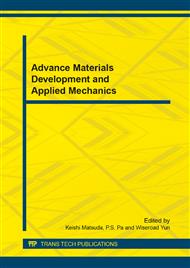p.242
p.249
p.253
p.257
p.262
p.266
p.272
p.276
p.283
Research on Performance of Foundry Sand under the Effect of Chemical Binder
Abstract:
This paper makes an experiental research on the performance of foundry sand under the effect of chemical binder. It discoveries the raw sand with different origin will have different properties even though they have the same particle size. The properties of their molding sand are also obviously different. For the raw sand that in the same particle size with similar acid demand value and four-screen distribution, the better grain shape will earn them a higher molding sand strength even though they have higher clay content. Under the effect of liquid binder, compared to the molding sand mixed from the sand of three-screen distribution, the molding sand mixed from those of four-screen distribution sand with other properties similar will have a higher tensile strength While under the effect of solid phenolic resin adhesive, the three-screen sand with good grain shape will have a high sand strength.
Info:
Periodical:
Pages:
262-265
Citation:
Online since:
July 2014
Authors:
Keywords:
Price:
Сopyright:
© 2014 Trans Tech Publications Ltd. All Rights Reserved
Share:
Citation:


